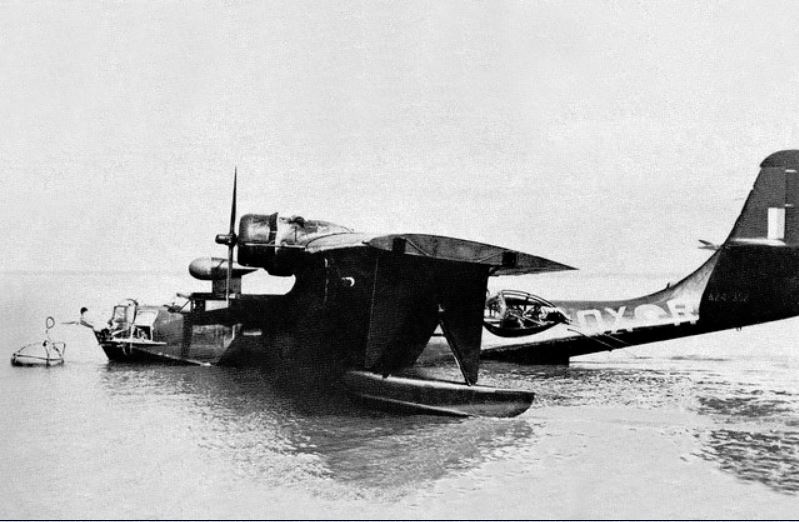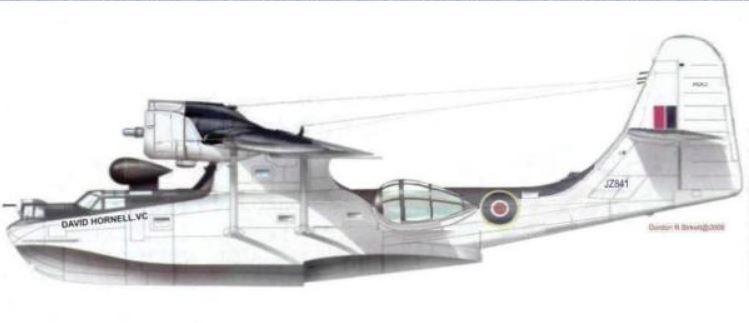Difference between revisions of "Consolidated PBY Catalina"
From Our Contribution
(Created page with "{{infobox aircraft | image = File:.jpg | caption = | image2 = File:.jpg | caption2 = | aircrafttype = Seaplane | aircraftrole =...") |
(→Crew members) |
||
| (14 intermediate revisions by the same user not shown) | |||
| Line 1: | Line 1: | ||
{{infobox aircraft | {{infobox aircraft | ||
| − | | image = [[File:.jpg]] | + | | image = [[File:Catalina_A24-358.jpg]] |
| − | | caption = | + | | caption = Catalina A24-358 |
| − | | image2 = [[File:.jpg]] | + | | image2 = [[File:RAAF_PBY_Catalina_A24-377.jpg]] |
| − | | caption2 = | + | | caption2 = RAAF Catalina A24-377 |
| aircrafttype = Seaplane | | aircrafttype = Seaplane | ||
| aircraftrole = Maritime patrol bomber, search and rescue | | aircraftrole = Maritime patrol bomber, search and rescue | ||
| − | | aircraftdesigner = | + | | aircraftdesigner = Consolidated Aircraft team |
| aircraftmanufacturer = Consolidated Aircraft | | aircraftmanufacturer = Consolidated Aircraft | ||
| aircraftproduced = 2,661 in US; 620 Canada; 24 Soviet Union | | aircraftproduced = 2,661 in US; 620 Canada; 24 Soviet Union | ||
| − | | aircraftnumberbuilt = 3, | + | | aircraftnumberbuilt = 4,051, with 3,031 during war time |
| aircraftprimaryusers = US Navy, US Army Air Force; TAF; RCAF; RAAF | | aircraftprimaryusers = US Navy, US Army Air Force; TAF; RCAF; RAAF | ||
| aircraftinservice = 1936 | | aircraftinservice = 1936 | ||
| Line 16: | Line 16: | ||
==Remarks== | ==Remarks== | ||
| − | One of the most widely used seaplanes of World War II, it was used by the US Navy, US Army Air Force; TAF; RCAF; RAAF | + | One of the most widely used seaplanes of World War II, it was used by the US Navy, US Army Air Force; TAF; RCAF; RAAF. Australian versions were the Catalina IVB and the Catalina VI. Of interest 138 of the first model, the PBN-1 were provided to the Soviet Navy. |
| + | |||
| + | |||
| + | Primary purpose was in anti-submarine warfare, both in the Atlantic and the Pacific theatres. Some also patrolled the Indian Ocean from Seychelles and Ceylon. However, the also served as convoy escorts, and they provided maritime patrols. A patrolling Catalina found the Japanese fleet approaching Midway, and saved the Royal Navy's Indian Ocean fleet, by early observation of the approaching Japanese carrier fleet. Along the way they sank 40 U_Boats. | ||
| + | |||
| + | |||
| + | The RAAF operated Catalinas as night raiders, with Nos 11, 20, 42, and 43 Squadrons laying mines deep inside Japanese lines to disrupt their shipping. During World War II, Qantas flew commercial passengers from Suva to Sydney and from Colombo to Perth. Post war many of the aircraft were sold to smaller nations such as Chile and Brazil, and to commercial operators. | ||
| + | |||
==General characteristics== | ==General characteristics== | ||
| − | + | *Crew: Ten - pilot, co-pilot, bow turret gunner, flight engineer, radio operator, navigator, radio operator, to waist gunners, ventral gunner. | |
| − | *Crew: | + | *Length: 19.46 m |
| − | *Length: | + | *Wingspan: 31.70 m |
| − | *Wingspan: | + | *Height: 6.15 m |
| − | *Height: | + | *Empty weight: 9, 485 kg |
| − | *Empty weight: | + | *Max takeoff weight: 16,066 kg |
| − | *Max takeoff weight: | + | *Powerplant: 2 x Pratt & Whitney Twin Wasp radial engines 1,200 hp each |
| − | *Powerplant: | + | *Maximum speed: 314 km/h |
| − | *Maximum speed: | + | *Range: 4,055 km |
| − | *Range: | + | *Service ceiling: 4,815 m |
| − | *Service ceiling: | ||
*Armament | *Armament | ||
| − | *Guns: | + | *Guns: 3 x 7.62 mm machine guns; 2 x 12.7mm machine guns |
| − | *Bombs: | + | *Bombs:1,814 kg of bombs or depth charges |
| + | Following the Surrender of Japan in September 1945, RAAF Catalinas were used to deliver medical supplies to liberated POW camps before flying survivors back to Australia. On 30 August 1945 a flight of 9 RAAF Catalinas landed in Singapore bearing medical supplies and documents in preparation for the Japanese surrender, becoming the first allied forces to enter the island since 1942. In total, Australia operated 168 Catalinas during the war. The aircraft continued to be used in immediate post-war period, being used to assist with the repatriation of former prisoners of war from Singapore to Australia. For further aircraft details see http://www.adf-serials.com/2a24.shtml | ||
==Crew members== | ==Crew members== | ||
| + | ===[[No. 20 Squadron RAAF]]=== | ||
| + | * [[Stanley Neil Butcher]] 2 Feb - 25 Oct 1945 | ||
| + | |||
| + | ==Ground Crew== | ||
| + | |||
| + | ===[[No. 111 Air Sea Rescue Flight RAAF]]=== | ||
| + | *[[Raymond George Bunney]] 13 Dec 1944 - ??/??/1945 | ||
| + | |||
| + | ===[[No. 42 Squadron RAAF]] Melville Bay and Darwin, NT=== | ||
| + | *[[Vernon Wallace Marsh]] 1944 | ||
| + | |||
| + | ===Individual Aircraft=== | ||
| + | '''RAAF Catalina A24-359''' Joined No. 43 Squadron on 21 May 1945, and was sold to Airmotive on 18 May 1953. | ||
| + | |||
| + | '''Manila to Darwin via Moratai 14 Oct 1945''' | ||
| + | *[[Norman Lenard (Bob) Dunnell]] Returning POW | ||
| + | |||
| + | |||
| + | '''RAAF Catalina A24-377''' Joined No. 20 Squadron on 18 Aug 1945, and following the return of POWs was transferred to the 3 OTU on 25 Jan 1946. The plane was sold to Airmotive on 18 May 1953 | ||
| + | |||
| + | '''Manila to Darwin to Perth''' | ||
| + | *[[Charles William (Tiny) Gray]] Returning POW | ||
| + | |||
| + | '''Darwin to Perth October 1945''' | ||
| + | *[[Norman Lenard (Bob) Dunnell]] Returning POW | ||
[[category:Aircraft]] | [[category:Aircraft]] | ||
Latest revision as of 18:07, 1 December 2023
Contents
Remarks
One of the most widely used seaplanes of World War II, it was used by the US Navy, US Army Air Force; TAF; RCAF; RAAF. Australian versions were the Catalina IVB and the Catalina VI. Of interest 138 of the first model, the PBN-1 were provided to the Soviet Navy.
Primary purpose was in anti-submarine warfare, both in the Atlantic and the Pacific theatres. Some also patrolled the Indian Ocean from Seychelles and Ceylon. However, the also served as convoy escorts, and they provided maritime patrols. A patrolling Catalina found the Japanese fleet approaching Midway, and saved the Royal Navy's Indian Ocean fleet, by early observation of the approaching Japanese carrier fleet. Along the way they sank 40 U_Boats.
The RAAF operated Catalinas as night raiders, with Nos 11, 20, 42, and 43 Squadrons laying mines deep inside Japanese lines to disrupt their shipping. During World War II, Qantas flew commercial passengers from Suva to Sydney and from Colombo to Perth. Post war many of the aircraft were sold to smaller nations such as Chile and Brazil, and to commercial operators.
General characteristics
- Crew: Ten - pilot, co-pilot, bow turret gunner, flight engineer, radio operator, navigator, radio operator, to waist gunners, ventral gunner.
- Length: 19.46 m
- Wingspan: 31.70 m
- Height: 6.15 m
- Empty weight: 9, 485 kg
- Max takeoff weight: 16,066 kg
- Powerplant: 2 x Pratt & Whitney Twin Wasp radial engines 1,200 hp each
- Maximum speed: 314 km/h
- Range: 4,055 km
- Service ceiling: 4,815 m
- Armament
- Guns: 3 x 7.62 mm machine guns; 2 x 12.7mm machine guns
- Bombs:1,814 kg of bombs or depth charges
Following the Surrender of Japan in September 1945, RAAF Catalinas were used to deliver medical supplies to liberated POW camps before flying survivors back to Australia. On 30 August 1945 a flight of 9 RAAF Catalinas landed in Singapore bearing medical supplies and documents in preparation for the Japanese surrender, becoming the first allied forces to enter the island since 1942. In total, Australia operated 168 Catalinas during the war. The aircraft continued to be used in immediate post-war period, being used to assist with the repatriation of former prisoners of war from Singapore to Australia. For further aircraft details see http://www.adf-serials.com/2a24.shtml
Crew members
No. 20 Squadron RAAF
- Stanley Neil Butcher 2 Feb - 25 Oct 1945
Ground Crew
No. 111 Air Sea Rescue Flight RAAF
- Raymond George Bunney 13 Dec 1944 - ??/??/1945
No. 42 Squadron RAAF Melville Bay and Darwin, NT
- Vernon Wallace Marsh 1944
Individual Aircraft
RAAF Catalina A24-359 Joined No. 43 Squadron on 21 May 1945, and was sold to Airmotive on 18 May 1953.
Manila to Darwin via Moratai 14 Oct 1945
- Norman Lenard (Bob) Dunnell Returning POW
RAAF Catalina A24-377 Joined No. 20 Squadron on 18 Aug 1945, and following the return of POWs was transferred to the 3 OTU on 25 Jan 1946. The plane was sold to Airmotive on 18 May 1953
Manila to Darwin to Perth
- Charles William (Tiny) Gray Returning POW
Darwin to Perth October 1945
- Norman Lenard (Bob) Dunnell Returning POW

